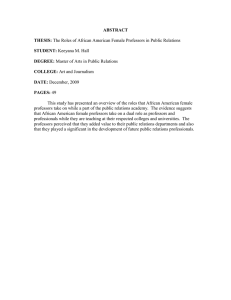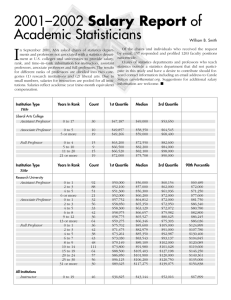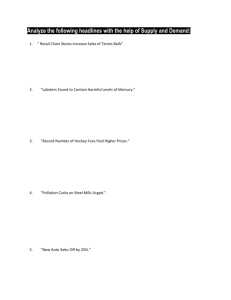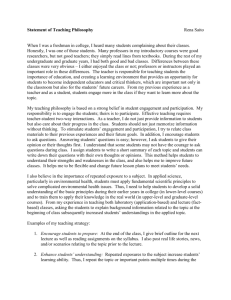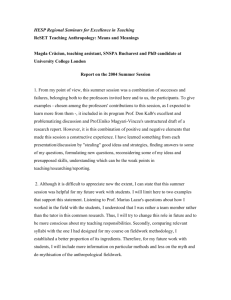1-1
advertisement
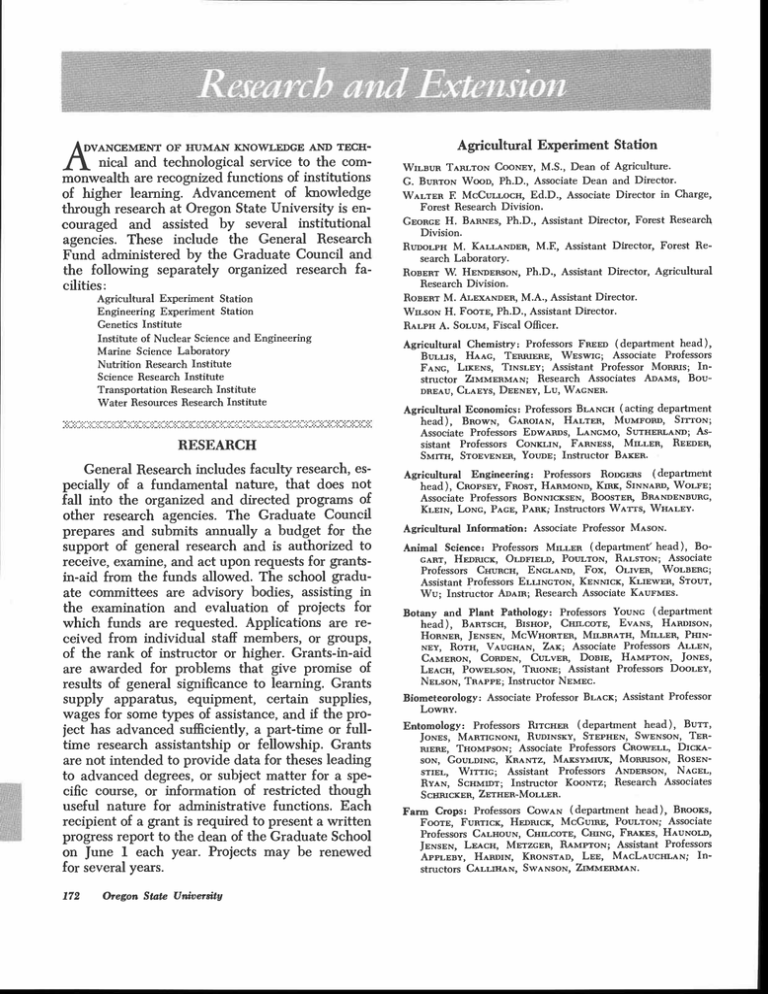
Agricultural Experiment Station ADVANCEMENT OF HUMAN KNOWLEDGE AND TECH- 1-1 nical and technological service to the commonwealth are recognized functions of institutions of higher learning. Advancement of knowledge through research at Oregon State University is en- couraged and assisted by several institutional agencies. These include the General Research Fund administered by the Graduate Council and the following separately organized research facilities : Agricultural Experiment Station Engineering Experiment Station Genetics Institute Institute of Nuclear Science and Engineering Marine Science Laboratory Nutrition Research Institute Science Research Institute Transportation Research Institute Water Resources Research Institute RESEARCH General Research includes faculty research, es- pecially of a fundamental nature, that does not fall into the organized and directed programs of other research agencies. The Graduate Council prepares and submits annually a budget for the support of general research and is authorized to WILBUR TARLTON COONEY, M.S., Dean of Agriculture. G. BURTON WOOD, Ph.D., Associate Dean and Director. WALTER E McCuLLOCH, Ed.D., Associate Director in Charge, Forest Research Division. GEORGE H. BARNES, Ph.D., Assistant Director, Forest Research Division. RUDOLPH M. KALLANDER, M.E, Assistant Director, Forest Research Laboratory. ROBERT W. HENDERSON, Ph.D., Assistant Director, Agricultural Research Division. ROBERT M. ALEXANDER, M.A., Assistant Director. WILSON H. FOOTE, Ph.D., Assistant Director. RALPH A. SOLUM, Fiscal Officer. Agricultural Chemistry: Professors FREED (department head), BULLIS, HAAG, TERRIERE, WESWIG; Associate Professors FANG, LIKENS, TINSLEY; Assistant Professor Momus; Instructor ZIMMERMAN; Research Associates ADAMS, BouDREAU, CLAEYS, DEENEY, LU, WAGNER. Agricultural Economics: Professors BLANCH (acting department head), BROWN, GAROIAN, HALTER, MUMFORD, SITTON; Associate Professors EDWARDS, LANGMO, SUTHERLAND; Assistant Professors CONKLIN, FARNESS, MILLER, REEDER, SMITH, STOEVENER, YOUDE; Instructor BAKER. Agricultural Engineering: Professors RODGERS (department head), CROPSEY, FROST, HARMOND, KIRK, SINNARD, WOLFE; Associate Professors BONNICKSEN, BOOSTER, BRANDENBURG, KLEIN, LONG, PAGE, PARK; Instructors WATTS, WHALEY. Agricultural Information: Associate Professor MASON. Animal Science: Professors MILLER (department' head), Bo- receive, examine, and act upon requests for grantsin-aid from the funds allowed. The school gradu- GART, HEDRICK, OLDFIELD, POULTON, RALSTON; Associate ate committees are advisory bodies, assisting in the examination and evaluation of projects for which funds are requested. Applications are received from individual staff members, or groups, of the rank of instructor or higher. Grants-in-aid are awarded for problems that give promise of results of general significance to learning. Grants supply apparatus, equipment, certain supplies, Wu; Instructor ADAIR; Research Associate KAUFMES. wages for some types of assistance, and if the project has advanced sufficiently, a part-time or fulltime research assistantship or fellowship. Grants are not intended to provide data for theses leading to advanced degrees, or subject matter for a spe- cific course, or information of restricted though useful nature for administrative functions. Each recipient of a grant is required to present a written progress report to the dean of the Graduate School on June 1 each year. Projects may be renewed for several years. 172 Oregon State University Professors CHURCH, ENGLAND, Fox, OLIVER, WOLBERG; Assistant Professors ELLINGTON, KENNICK, KLIEWER, STOUT, Botany and Plant Pathology: Professors YOUNG (department head), BARTSCH, BISHOP, CHILCOTE, EVANS, HARDISON, HORNER, JENSEN, MCWHORTER, MILBRATH, MILLER, PHIN- NEY, ROTH, VAUGHAN, ZAK; Associate Professors ALLEN, CAMERON, CORDEN, CULVER, DOME, HAMPTON, JONES, LEACH, POWELSON, TRIONE; Assistant Professors DOOLEY, NELSON, TRAPPE; Instructor NEMEC. Biometeorology: Associate Professor BLACK; Assistant Professor LOWRY. Entomology: Professors RITCHER (department head), BUTT, JONES, MARTIGNONI, RUDINSKY, STEPHEN, SWENSON, TERRIERE, THOMPSON; Associate Professors CROWELL, DIcKA- SON, GOULDING, KRANTZ, MAKSYMIUK, MORRISON, ROSENSTIEL, WITTIG; Assistant Professors ANDERSON, NAGEL, RYAN, SCHMIDT; Instructor KOONTZ; Research Associates SCHRICKER, ZETHER-MOLLER. Farm Crops: Professors COWAN (department head), BROOKS, FOOTE, FURTICK, HEDRICK, MCGUIRE, POULTON; Associate Professors CALHOUN, CHILCOTE, CHING, FRAKES, HAUNOLD, JENSEN, LEACH, METZGER, RAMPTON; Assistant Professors APPLEBY, HARDIN, KRONSTAD, LEE, MACLAUCHLAN; In- structors CALLIHAN, SWANSON, ZIMMERMAN. Fisheries and Wildlife: Professors SCOTT (department head), BOND, DOUDOROFF, KRUEGER, PHINNEY, RAYNER, WARREN; Associate Professors GASHWILER, HORTON, KUHN, MILLEMAN, WIGHT; Assistant Professors ANDERSON, BREESE, CAMPBELL, CHADWICK, DAVIS, FRYER, GARRISON, HALL, LIGHTFOOT, MCINTIRE, SHUMWAY, VERTS, WAGNER; Instructors EASLEY, HANSEN. Food Science and Technology: Professors SCHULTZ (department head), CAIN, SAMUELS, SINNHUBER; Associate Professors ANCLEMIER, HARVEY, ONSDORFF, SATHER, WALES, YANG; Assistant Professors BEAVERS, BILLS, LAW, LINDSAY, MONTGOMERY, VARSEVELD, WILLITS, YU; Research Associates CRAWFORD, LEE, LIBBEY, PEREIRA, SIEK, WROLSTAD, YOSHIKAWA. Forest Research Laboratory (Forest Management) : Professors BEVER (department head), BERG; Associate Professors CHING, HERMANN, LAVENDER; Assistant Professors BLACK, HOOVEN, IRGENS-MOLLER, KANGUR, WARING, ZAERR, ZAVITKOVSKI. NAGEL, NEWTON, Forest Research Laboratory (Forest Products) : Professors ELLIS (department head), Professors AFT, JOHNSON; ESPENAS, SNODGRASS; Associate Assistant Professors KOZLIK, KRAHMER, LEH- MANN, MILLER, MOLYNEUX, OVERHOLSER, SCHROEDER; Instructors KUNESH, MOTHERSHEAD. Forestry Science: Professors BARNES (department head), FERRELL, KENISTON, REICHART, WHEELER; Associate Professors JAENICKE, KRYGIER, MCKIMMY; Assistant Professor McLAREN. Home Economics Research: Professors STORVICK (department head), MACKEY; Assistant Professors BUBL, PETERS; Instructors BENSON, EDWARDS. Horticulture: Professors APPLE (department head), COMPTON, FRAZIER, HANSEN, PAINTER, ROBERTS, ZIELINSKI; Associate Professors BAGGETT, BLANEY, CARREN, MACK, WADSWORTH, WESTWOOD; Assistant Professors CRABTREE, LAGERSTEDT, LAWRENCE, THOMPSON; Research Associate KLEMM. FROST; Instructor integrated to provide the greatest public good. (2) Increasing efficiency of agricultural and forest production. (3) Improving the processing, distribution, and marketing of products of agriculture and forestry. (4) Testing and developing new crops and new uses for old crops as a means of reducing crop surpluses. (5) Collecting and analyzing basic information needed in development of comprehensive agricultural and forestry programs and policies. (6) Advancement of human wellbeing through research in selection, preparation, and preservation of food; determining of human nutrition requirements; and role of food in maintaining optimal health; selection, construcThe Station cooperates with the U. S. Department of Agriculture, the U. S. Department of the Interior, other Federal and State agencies, and the counties in which the branch stations are located. A number of Federal scientists are located in Oregon working on problems of a regional nature. The Agricultural Research Division of the Station is made up of fifteen campus departments and twelve branch stations. Some staff members are full time in research while others also teach in the Schools of Agriculture, Science, Engineering, and Home Economics. In addition, some 190 graduate students devote half time to research as Research Assistants. The research is aimed at problem solving and covers all phases of agricultural production, processing, and marketing; conservation, management, and use of renewable natural resources-soil, water, range, fish, and wildlife; human nutrition and home economics; and basic biological sciences which support the applied fields. Increasing attention is being devoted to basic research-the fundamental discoveries and knowledge es- WHALEY. Microbiology: Professors ELLIKER (department head), ANDERSON, BOLLEN, GILMOUR, MORITA, PILCHER; Associate Professors PARKS, SANDINE; Assistant Professor FRYER; Research Associate Lu. Poultry Science: Professor PARKER (department head), ARsCOTT, BERNIER, HARPER; Associate Professor MCCLUSKEY. Soils: Professors CHENEY (department head), DAWSON, HARWARD, JACKSON, KNOX, TARRANT, YOUNGBERG; Associate Professors BOERSMA, MOORE, D. G., MOORE, D. P. SIMONSON, YOUNG; Assistant Professors BALSTER, DYRNEss, PARSONS; Research Associates DEBACKER, PECK, WOLLUM. Statistics: Professors CALVIN (department head), OVERTON, PETERSEN; Associate Professor BLACK; Assistant Professors LOWRY, ROWE. Veterinary Medicine: Professors DICKINSON (department head), MUTH, PETERSON; Associate Professors BONE, KNAPP, SMITH; Assistant Professors HARR, HELFER, MATTSON, STEVENS; Research Associates BROWN, CLARY, KELSAY. Water Resources Research Institute: Research Associate KARR. Branch Experiment Stations: Professors BULLOCK, OVESON, MCARTHUR, MELLENTHIN, SAWYER; Associate Professors GROSS, management tion, and care of clothing and household fabrics. ATHERTON, CORDER, CURRIER, GRAHAM, Irrigation Water Forecasting: Professor The Oregon Agricultural Experiment Station was organized July 1, 1888, in accordance with the Hatch Act of 1887. It now includes a central station at Corvallis and twelve branch stations so located as to cover the varying agricultural conditions of Oregon. It investigates problems in agriculture, home economics, forestry, fisheries, and wildlife; its general objectives follow: (1) Conservation and efficient use of the State's natural resources including soil, water, fish, wildlife, forest, and ranges and their sential to solving problems. With the diversity of growing conditions in the State, the establishment of off-campus programs, including the branch stations, has been necessary. Crops and animals are produced in areas with rainfall varying from 8 to 100 inches, altitudes ranging from sea level to a mile high, a growing season extending from 63 to 283 days, and on land including more than 400 different soil types. The research departments are Agricultural Economics, Animal Science, Poultry Science, Veterinary Medicine, Fisheries and Wildlife, Farm Crops, Horticulture, Food Science and Technology, Soils, Agricultural Engineering, Microbiology, Agricultural Chemistry, Botany and Plant Pathology, Entomology, and Home Economics. The branch experiment stations are John Jacob Astor (As- toria), Eastern Oregon (Union), Klamath, Malheur (Ontario), Mid-Columbia (Hood River and The Dalles), North Willamette (Aurora), Pendleton, Sherman (Moro), Southern Oregon (Med- ford), Squaw Butte (Bums), Umatilla (Hermiston), and Central Oregon (Redmond). HOFFMAN, JOHNSON, LOMBARD, RALEIGH, ROHDE, RUMBERG, TICKNOR; Assistant Professors CARTER, CLAY- POOL, DAVIDSON, ELLER, FITCH, HALL, MCDERMID, PUM- Permanent field units or laboratories are maintained for research at Milton for beef feeding, Yaquina for marine problems, PHREY, RYDRYCH, SNEVA, WALLACE, WESTIGARD, YUNGEN, ZWICK; Instructor SHEETS. Astoria for seafood processing, and Brookings for lily bulb production. Research and Extension 173 The Forest Research Division of the Station consists of two complementary departments: Forest Science, and the Forest Research Laboratory. The Forest Science Department is concerned with forest research conducted by staff jointly appointed with the School of Forestry and related biological science departments. Chief areas of research currently include forest entomology, genetics, pathology, physiology, soils, marketing, watersheds, and wood anatomy. Applied research in forest engineering is concerned with roads and timber transportation. The Forest Research Laboratory was established to aid the JOHN GRANVILLE JENSEN, Ph.D., Industrial Resources. JAMES CHESTER LOONEY, M.S., E.E., Solid State Electronics. PHILIP COOPER MAGNUSSON, Ph.D., Electrical Engineering Analysis. THOMAS JOHN MCCLELLAN, M.Engr., Structural Engineering. ROBERT EUGENE MEREDITH, Ph.D., Electrochemical Engineering. FRED MERRYFIELD, M.S., Sanitary Engineering. ROBERT RAY MICHAEL, M.S., Electrical Materials and Instrumentation. economic growth of Oregon through research to develop the maximum yield from forests and the best utilization of the forest resource. The program was begun with a small general fund appropriation for forest products research in 1941; expanded in 1947 when a severance tax on logs was established to finance forest products and forest management research; and given substantial impetus with construction of the Laboratory at Corvallis in 1957. From 1953 to 1961 the Laboratory (then known JOHN GLENN MINGLE, M.S., Automotive Engineering. ROGER DEAN OLLEMAN, Ph.D., Metallurgical Engineering. as the Oregon Forest Research Center) was administered by the Forest Protection and Conservation Committee, a state agency affiliated with the State Board of Forestry; in 1961 it was consolidated with Oregon State University. Major effort in forest products is on utilization of wood resi- JOHN LOUIS SAUGEN, Ph.D., Control Systems. ROBERT JAMES SCHULTZ, M.S., Surveying and Photogrammetry. MILTON CONWELL SHEELY, B.S., Manufacturing Processes. dues, discovery of new products, more efficient processing meth- ods, and improvement in the utilization and serviceability of wood. In forest management, research is conducted in the fields of fire and fire weather, forest ecology, genetics, growth and yield, mammalogy, pathology, regeneration, and soils. These programs, which derive their principal support from the forest industry, supply results of research and provide technical information to timber owners, manufacturers, users of forest products, and others who are interested. Both departments of the Forest Research Division undertake cooperative research in specialized areas financed by individuals, corporations, associations, and government agencies. The Division benefits from the advice and counsel of two advisory committees, one in forest management and one in forest products, representing industrial associations and organizations and public forestry agencies. Engineering Experiment Station Administrative Officers Roy E. LIEUALLEN, Ed.D., Chancellor, Oregon State System of Higher Education. OLAF GUSTAV PAASCHE, M.S., Metallurgical Engineering. DONALD CHARLES PHILLIPS, Ph.D., Sanitary Engineering. JAMES LEAR RIGGS, Ph.D., Industrial Engineering. JOHN CLAYTON RNGLE, Ph.D., Nuclear Engineering. JEFFERSON BELTON RODGERS, A.E., Agricultural Engineering. Louis SLEGEL, Ph.D., Mechanical Engineering. CHARLES EDWARD SMITH, Ph.D., Applied Mechanics. Louis NELSON STONE, B.S., High Voltage and Computers. JESSE SEBURN WALTON, B.S., Chemical and Metallurgical Engineering. LEONARD JOSEPH WEBER, M.S., Communications Engineering. JAMES RICHARD WELTY, Ph.D., Transport Phenomena. CHARLES EDWARD WICKS, Ph.D., Chemical Engineering. By act of the Board of Regents of Oregon State College on May 4, 1927, the Engineering Experiment Station was established at Corvallis to serve the State in a manner broadly outlined by the following policy: To serve the industries, utilities, professional engineers, public departments, and engineering teachers by making investigations of significance and interest to them. To stimulate and elevate engineering education by developing the research spirit in faculty and students. To publish and distribute through bulletins, circulars, and technical articles in periodicals the results of such studies, surveys, tests, investigations, and research as will be of greatest benefit to the people of Oregon, and particu- JAMES HERBERT JENSEN, Ph.D., President, Oregon State Univer- larly to the State's industries, utilities, and professional sity. GEORGE WALTER GLEESON, Ch.E., Dean, School of Engineering, and Director, Engineering Experiment Station. JAMES GEORGE KNUDSEN, Ph.D., Assistant Dean, School of Engineering, in charge, Engineering Experiment Station. JAMES KENNETH MUNFORD, Ed.D., Director of Publications. engineers. Station Staff GORDON WILLIAM BEECROFT, C.E., Highway Engineering. CHARLES EDWARD BEHLKE, Ph.D., Hydraulics. J. RICHARD BELL, Ph.D., Soil Mechanics and Foundations. RICHARD WILLIAM BOUBEL, Ph.D., Air. Pollution. FREDRICK JOSEPH BURGESS, M.S., Water Resources Engineering. HANS JUERGEN DASsLKE, Ph.D., Stress Analysis. EDWARD ARcHIE DALY, M.S., Nuclear Engineering. WILLIAM FREDERICK ENGESSER, M.S., Industrial Engineering. GRANT STEPHEN FEIKERT, M.S., E.E., Radio Engineering. CHARLES OSWALD HEATH, M.S., Engineering Materials. ARTHUR DOUGLAS HUGHES, M.S., tioning. 174 Oregon State University Heat, Power, and Air Condi- The Engineering Experiment Station is an integral part of the School of Engineering. All staff members and laboratory facilities of the Engineering School are available for the investiga- tive work of the station to the extent of funds allocated or contributed for this purpose. Much of the work of the station has been made possible by the assistance of industries and state and national associations. Inquiries concerning cooperative projects are welcomed. The dean of engineering is the director of the Engineering Experiment Station and guides the operation of the station to conform with state and institutional policies. The assistant dean of engineering acts as the administrator in charge, technical edi- tor of publications, and as chairman of the station executive council composed of senior station staff representing the various departments of the School of Engineering. The active staff is composed of members of the instructional staff who may be in- terested in various specific research projects, or of research fellows who are pursuing graduate study and are assigned to parttime work in the Station. Experts who are especially qualified by training and experience to advise on the investigations in certain fields have been appointed to the staff as special counselors. Among these are executives and engineers representing major industries of Oregon and the Northwest, prominent consulting engineers, and leading engineers of Federal agencies and State departments. Some technical assistants have been supported by manufacturers and industrial associations interested in working out specific problems. Genetics Institute RALPH BOGART, Ph.D., Director. Professors: P E. BERNIER, S. N. BROOKS, L. D. CALVIN, J. R. COWAN, E. J. DORNFELD, W H. FooTE, W. A. FRAZIER, J. A. HARPER, IRWIN, ISENBERG, W. S. OVERTON, R. M. STORM, CHIH H. WANG. Associate Professors: J. R. BAGGETT, H. R. CAMERON, K. L. CHAMBERS, K. K. CHING, D. C. ENGLAND, C. W. Fox, D. K. FRASER, ALFRED HAUNOLD, R. J. METZGER, J. D. MOLLER, A. OWCZARZAK, L. W. PARKS, W. E. SANDINE, E. R. SCHWINGHAMER, R. R. SILEN, W. P. STEPHEN, and Q. B. ZIELINSKI. Assistant Professors: ANNETTE BAICH, R. V. FRAKES, PATRICIA HARRIS, H. IRGENS-MOLLER, R. H. KLIEWER, W. E. KRONSTAD, KENNETH ROWE, MAXINE M. THOMPSON, and F. M. search and instruction in marine biology and oceanography while a second wing houses fisheries and engineering research. An auditorium and public aquarium-museum is located in the third or central wing along with a library and classroom. A nontoxic sea-water system provides sea water free of metallic contaminants to all biological laboratories. Dormitory-type sleeping accommodations are available for eight men and six women. A program of research and instruction is being developed in cooperation with the departments of Zoology, Botany, Microbiology, Civil Engineering, Fisheries and Wildlife, and Oceanography. The laboratory is operating on a twelve-month basis. Research workers have the opportunity to sample open-ocean organisms from the 180-foot oceanographic vessel Yaquina, and estuarine organisms from half a dozen small boats operated by the laboratory. Research units from the U. S. Public Health Service, Oregon State Game Commission, and the Fish Commission of Oregon are housed in the laboratory. Nuclear Science and Engineering Institute STOUT. Established in 1963, the Genetics Institute serves to integrate the research activities in genetics carried on by personnel in the biological science departments of the University. The function of the Institute is to strengthen genetics as a unifying discipline for biology, biochemistry, and biophysics. The Genetics Institute is administered by a director, assisted by an elected Genetics Board. The Institute staff comprises some 33 geneticists from the several departments in the Schools of Agriculture, Forestry, and Science. Extensive facilities for genetics research are provided by the departments with which the geneticists are affiliated. Active research is under way in the following areas: formal genetics, cytology and cytogenetics, evolution and speciation, quantitative genetics, microbial and fungal genetics, plant genetics and improvement, animal genetics and improvement, and forest genetics. These facilities and the competent faculty provide outstanding opportunities for graduate teaching and research. Marine Science Laboratory Newport, Oregon Administrative Officers WAYNE V. BURT, Ph.D., Sc.D., Director. THOMAS G. SCOTT, Ph.D., Co-director. Resident Staff Marine Biology and Oceanography Professor: JOEL W. HEDGPETH, Ph.D., Resident Director. Assistant Professor: J. J. GONOR, Ph.D. Research Associates: R. G. REDMOND, D. A. YOUNG. Fisheries and Wildlife Associate Professor: W. J. McNEIL, Ph.D., Resident CoDirector. Assistant Professor: W. P. BREESE. Assistant in Fisheries: N. E. STEWART; G. A. GEBHARDT. Assistant in Water Pollution Biology: R. C. CouRTRIGHT. Oregon State University is becoming a regional center for all types of marine research and instruction. Off-campus activi- ties are concentrated at a new 47-acre laboratory site on the south shore of Yaquina Bay about a mile from the ocean. A new dock has been built to accommodate research vessels up to 250 feet in length. The new laboratory which opened February 1, 1965, has 38,000 square feet of floor space. One wing has facilities for re- The Institute is charged with the responsibility of coordinating curricular matters at the graduate and undergraduate level in the areas of nuclear science and engineering. The institute will coordinate various fellowship programs and graduate training programs in pertinent disciplines. Another function of the Institute is to make long range plans in developing institutional research facilities such as the research reactor and other major radiation sources. In coordination with the Radiation Center it will provide assistance to research workers in carrying out research endeavors involving the use of radioisotopes and ionizing radiation. Nutrition Research Institute CLARA A. STORVICK, Ph.D., Director. Professors: V. H. CHELDELIN, O. C. COMPTON, M. D. DAWSON, E. M. DICKINSON, P. R. ELLIKER, H. J. EVANS, M. L. FINCKE, V. H. FREED, J. R. HAAG, B. E. HAWTHORNE, T. L. JACKSON, H. M. KRUEGER, J. C. MILLER, O. H. MUTH, J. E. OLDFIELD, H. W. SCHULTZ, R. O. SINNHUBER, C. A. STORVICK, L. C. TERRIERE, P. H. WESWIG, G. B. WOOD. Associate Professors: A. F. ANGLEMIER, G. H. ARscoTT, G. H. BEAUDREAU, R. R. BECKER, W. G. BROWN, D. P. MOORE, A. T. RALSTON, R. L. SMITH, C. TANK, 1. J. TINSLEY. Assistant Professors: F. W. ADAMS, D. O. CHILCOTE, D. C. CHURCH, F. M. STOUT. This new Institute had its origin on the campus in 1964, recognizing that food needs and resources constitute a basic and continuing problem of civilization. It has as its broad objectives the stimulation, encouragement, facilitation, and coordination of research efforts in the varied fields of nutrition as practiced in the departments and schools of Oregon State University. These objectives will be served through the sponsorship of interdepartmental and institutional seminars, symposia, and workshops; through coordination of nutrition course offerings, and through facilitating the entry of qualified scientists and graduate students into nutrition research through their particular disciplines. The Institute is headed by a Director and administered by an Advisory Board under the deans of Agriculture, the Graduate School, Home Economics, and Science. Research and Extension 175 Science Research Institute EXTENSION VERNON H. CHELDELIN, Ph.D., Director. T. E. KING, Ph.D., R. W. NEWBURGH, Ph.D., and A. B. SCOTT, Ph.D., Assistant Directors. Professors: V. H. CHELDELIN, IRVIN ISENBERG, T. E. KING, E. F. KURTH, D. L. MACDONALD, R. W. NEWBURGH, A. B. SCOTT, and C. H. WANG. Associate Professors: R. R. BECKER, V. J. BROOKES, F. W. DECKER, W. D. LooMIs, R. A. MACHAFFIE, E. J. TRIONE. Assistant Professors: A. BAICH, D. J. BAISTED, F. N. DOST, W. GAMBLE. the benefits of all the Oregon of higher education are brought to the peostate T ple of the State in their own communities. All divisions of the HROUGH EXTENSION SERVICES institutions Oregon State System of Higher Education seek through every means possible, so far the Division of Continuing Education and the Federal Cooperative Extension Service. Research Associates: SPENCER L. BAIRD, JR., C. BHUVANES- WARAN, MARY ANN DANKLEFF, M.ARGARET S. GIBSON, R. L. HOWARD, L. D. MENDENHALL, CATHERINE MEZEI, RAJA ROSENBLUTH, P. N. D. TSAO. The growth of scientific research on this campus during the past thirty years, coupled with a steady increase in support of research by outside agencies, resulted in the establishment in 1952 of the Science Research Institute. The Institute, operating within the framework of the School of Science, has three functions; first, to assist scientists at Oregon State in obtaining support for research projects; second, to aid in expediting their research programs and to promote interdisciplinary research; and third, to pursue an active research program fitted to the interest and competence of the Institute staff. Principal quarters of the Institute are in the Physics-Chemistry Building, with supplemental quarters in the Chemistry Build- ing and Covell Hall. Current studies by the Institute staff include fundamental projects in biochemistry, biophysics, organic chemistry, solid state chemistry, electrochemistry, microbiology, entomology, plant pathology, forest products, pharmacology, and atmospheric science which derive their support from Oregon State University, government research agencies, research foundations, and industrial concerns. Staff members of the Science Research Institute receive joint appointments in the Institute and the appropriate teaching departments. Research assistants employed by the Institute also receive appointments in the departments in which their advanced degrees are sought. Transportation Research Institute The Transportation Research Institute brings together the resources of the institution for research on transportation of agricultural and forest products, maintenance and operation problems in the trucking industry, traffic problems, and other problems related to the transportation industry. Water Resources Research Institute The importance of water for the economic and social development of Oregon resulted in the establishment in 1960 of the Water Resources Research Institute. The function of the Institute is to encourage, facilitate, and coordinate research at Oregon State University on the factors that affect the quantity and quality of water available for use by mankind. The Institute is administered by the Agricultural and Engineering Experiment Stations and is staffed by scientists of the various departments at Oregon State engaged in water resources research. Extensive facilities are available for Institute scientists including watershed lands, a soils laboratory, water and waste treatment plants, experimental waste treatment facilities, bacteriological and water quality laboratories, freshwater and marine biological laboratories, an experimental stream, and computing equipment for economic research. These facilities afford a unique opportunity for graduate and advanced undergraduate research and instruction. Graduate assistantships are available. Staff members provide both classroom and research instruction, and a graduate minor in water resources may be pursued by students majoring in departments participating in the Institute. 176 Oregon State University as resources and facilities permit, to serve the entire State. Extension activities are administered through Division of Continuing Education JAMES W SHERBURNE, Ph.D., Vice Chancellor for Continuing Education. WILLIAM BARROWS, B.A., Manager, Business Affairs. R. DUANE ANDREWS, Ph.D., Director, Continuation Centers. DANIEL W. FULLMER, Ph.D., Director, Development and Evaluation. LUKE F LAMB, Ed.D., Director, Educational Media. VIRON A. MOORE, Ed.D., Director, State Wide Services. JAMES M. Moalus, Ed.D., Head, Information Services. RALPH W. STEETLE, M.A., Director, Divisional Relations. The Division of Continuing Education is the agency of the Chancellor's Office primarily responsible for innovating, developing, and expediting adult educational and cultural programs, and providing the management by which instructional and serv- ice offerings of the Oregon State System of Higher Education are extended. Continuing higher education programs are offered for all interested Oregonians capable of profiting from this instruction. Through continuation centers the Division offers college and university courses of the Oregon State System of Higher Education. Special programs for various interest groups, semiworkshops, conferences, and consultant services are devel- oped to meet personal, social, and economic needs. Continuation centers are located on university and college campuses. Other centers may be located where demand for service and adequacy of educational facilities indicate. State Wide Services of the Division provide the management of adult educational and cultural programs, and the extension of instructional services of the Oregon State System of Higher Education not assigned to continuation centers or educational media. Independent study programs utilizing correspondence and television are administered. Special programs for business, university civil defense education, industry, government, international affairs, and alcohol studies are offered in local communities. Divisional services such as printing, duplicating, mailing, and recording functions are managed by State Wide Services. Educational Media is responsible for operating educational radio and television networks for the Oregon State System of Higher Education. Instruction, information, and enrichment are the goals of the stations with studios for two radio stations and two television stations located in Eugene, Corvallis, Salem, and Portland. Educational Media also operates audiovisual services which make available to schools, colleges, community groups, and other organizations the following: motion picture films, tape recordings, slides, and such professional and consulting services as planning and production of films, art work, graphics, demonstrations, and workshops. Audiovisual libraries are located in Corvallis, Ashland, and La Grande. Offices of the Vice Chancellor of the Division of Continuing Education are at Coliseum 219, University Campus, Corvallis, Oregon. Other Division offices on the campus include: Corvallis Continuation Center, room 304 Covell Hall; Information Services, room 220 Agricultural Hall; Educational Media, room 219 Coliseum; Audiovisual Services, room 131 Coliseum; and KOACAM-TV, room 303 Covell Hall. Federal Cooperative Extension Service Administration WILBUR T. COONEY, M.S., Dean. GENE MAURICE LEAR, M.P.A., Associate Dean and Director. JOSEPH REw Cox, M.S., Assistant Director. JEAN WILLARD SCHEEL, M.A., Assistant Director. EsTHER A. TASKERUD, Sc.D., Assistant Director. C. G. WEEDMAN, Administrative Assistant. State Leaders and State Agents CLIFFORD LovEJOY SMITH, Ph.D., State Training Leader. BURTON SEYMOUR HUTTON, B.S., State 4-H Club Leader. Extension Information-dissemination of information through mass media of communication, including servicing and training of personnel in communications methods, and development and use of mass media and visual aids. Part of this project is supported jointly with the Division of Continuing Education. Agricultural Production, Management, and Natural Resource Development-this project is concerned with the application of science and technology to the organization and operation of farming and ranching enterprises and the conservation and development of agricultural resources. Subject matter fields involved are: animal husbandry, crops, certification of seeds and plants, dairying, agricultural engineering, entomology, farm management, range management, forestry, horticulture, plant M.A., State Extension Agent (4-H pathology, poultry, soils, and fish and wildlife management. Marketing and Utilization of Agricultural Projects-work CAL GRAHAM MONROE, M.S., State Extension Agent (4-H Club). ALICE Lois REDMAN, M.S., State Extension Agent (4-H Club). with marketing firms is emphasized. Objectives are to create greater efficiencies in processing, handling, and distribution through the application of new technology and improved marketing practices; to expand the market for Oregon farm products; and to get rapid adjustment by farmers, consumers, and RUTH ELIZABETH BRASHER, Club). GLENN A. KLEIN, M.A., State Extension Agent (4-H Club). MARY EUNICE ABBOTT, M.A., State Extension Agent. EvELYN AMANDA FUNK, M.Ed., State Extension Agent. MURLE SCALES, M.S., State Extension Agent. TURNER BOND, M.S., State Extension Agent. WILLIAM GERALD NIBLER, M.Ed., State Extension Agent. 'Louis MILTON OESTER, Ed.M., State Extension Agent. JACKSON Ross, M.S., State Extension Agent. MUBLE SCALES, M.S., State Extension Agent. BURTON E. BERGER, M.S., State Extension Agent. Federal Cooperative Extension performs one of the three major functions of Oregon State University, which are: resident teaching, research, and extension teaching. It extends the available information of Oregon State University, the United States Department of Agriculture, and other appropriate State and Federal agencies to every portion of the State. A staff of men and women resident in the counties, cooperatively supported by Oregon State, the United States Department of Agriculture, and the counties, and a resident staff of subject-matter specialists in agriculture and home economics work on approved projects. The work of the Extension Service includes all forms of offcampus instruction and assistance in those phases of agriculture, home economics, and related subjects that can be practically adapted to the needs of the people of the State. Unique teaching methods have been developed through the years, important among which is organization for self-help to bring widespread application of the principles presented. All counties in the State cooperate to bring extension programs to every community. Extension Projects. In order to assure maximum efficiency, extension work is conducted on the basis of definitely planned projects. These require approval by the proper Oregon State University authority and the U. S. Secretary of Agriculture before Federal and State funds appropriated for the work may be expended. The several distinct written projects from which cit. marketing firms to changes in technology, supply, and demand. In addition to agricultural economics, subject matter fields involved include food technology, dairy technology, and wood technology. Home Economics-subject matter areas covered under this project are in child development and human relations, foods and nutrition, home management and equipment, family economics, clothing and textiles, housing, and home furnishings. The project contributes toward economic well-being, desirable human relationships, assumption of civic responsibilities, and appreciation of the land in which we live. 4-H Club Work-through this program, Oregon State University provides an off-campus education service to the boys and girls of Oregon between the ages of 9 and 21. Objectives are to help young people acquire knowledge, skills, and attitudes that will contribute to their success as mature citizens in their home, their community, and their vocation. Agricultural and home eco- nomics projects are emphasized, but many others also are included. Community and Public Affairs-work under this project is designed to assist Oregon citizens to: understand principles and develop skills in the organization and leadership of groups; learn how to proceed systematically in the identification and resolution of public issues-local, state, national, and international; understand the political process through which public decisions are achieved and implemented in a democracy; plan and develop public facilities and services in such areas as health, safety, civil defense, recreation, general economic and social improve- ment; develop and implement long-range plans for the conservation and use of natural resources in the public interest-land, water, forests, and wildlife. zens of the State are receiving benefit include: Administration-overall administrative direction and leader- tions-provide the basis for conducting the extension program ship of programs and personnel. at the county level. Organization and Supervision of County Extension Opera- Research and Extension 177
